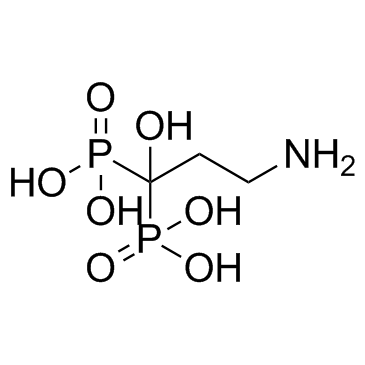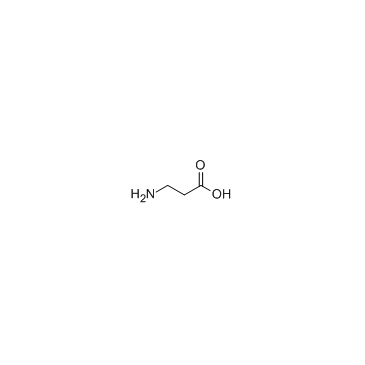Pamidronic acid
Modify Date: 2024-01-02 14:46:57

Pamidronic acid structure
|
Common Name | Pamidronic acid | ||
|---|---|---|---|---|
| CAS Number | 40391-99-9 | Molecular Weight | 235.06900 | |
| Density | 1.998 g/cm3 | Boiling Point | 658.7ºC at 760 mmHg | |
| Molecular Formula | C3H11NO7P2 | Melting Point | 226-228ºC | |
| MSDS | N/A | Flash Point | 352.2ºC | |
Use of Pamidronic acidPamidronic acid is a drug used to treat a broad spectrum of bone absorption diseases. |
| Name | Pamidronic acid |
|---|---|
| Synonym | More Synonyms |
| Description | Pamidronic acid is a drug used to treat a broad spectrum of bone absorption diseases. |
|---|---|
| Related Catalog | |
| Target |
Wnt, β-catenin[1] |
| In Vitro | Osteosarcoma cell viability decreases significantly in a concentration- and time-dependent manner at pamidronate concentrations ranging from 100 to 1000 μM, most consistently after 48 and 72 hours' exposure. In treated osteosarcoma cells, the lowest percentage cell viability is 34% (detected after 72 hours' exposure to 1000μM pamidronate)[1]. Pamidronate disodium inhibits Wnt and β-catenin signaling, which controls osteogenic differentiation in BMMSCs. Wnt3a, a Wnt and β-catenin signaling activator, reverses the negative effects caused by pamidronate disodium to salvage the osteogenic defect in BMMSCs[2]. |
| In Vivo | Pamidronic acid can significantly inhibit and even reverse early osteoarthritic subchondral bone loss, thus alleviating the process of cartilaginous degeneration. The mechanisms involved may be associated with the upregulation of OPG expression, and downregulation of RANKL, MMP-9 and TLR-4 expression[3]. |
| Cell Assay | Cell counts and cell viability assays are performed in cultures of osteosarcoma cells (POS, HMPOS, and COS31 cell lines) and fibroblasts after 24, 48, and 72 hours of incubation with pamidronate at concentrations of 0.001 to 1000 microM or with no drug (control treatment). Percentage viability is determined in cell samples for each concentration of pamidronate and each incubation time. A DNA fragmentation analysis is performed to assess bisphosphonate-induced apoptosis[1]. |
| Animal Admin | Rabbits: The rabbits are randomly divided into four groups. Sham-operated with vehicle treatment, OA induced by ACLT with vehicle treatment, OA-induced ACLT treated with short-term pamidronic acid treatment after ACLT, and ACLT treated with long-term PAM treatment. PAM is injected at the 4th week after ACLT in PAM-S and PAM-L groups, and followed by once monthly ear vein injections at a dosage of 3 mg/kg body weight. In the other groups, only saline infusions of equal volumes are administered. 10 animals are humanely sacrificed at both 2 and 10 weeks after pamidronic acid treatment. In the ACLT and Sham groups, five animals are sacrificed at 2, 4, 6, and 14 weeks after model establishment[3]. |
| References |
| Density | 1.998 g/cm3 |
|---|---|
| Boiling Point | 658.7ºC at 760 mmHg |
| Melting Point | 226-228ºC |
| Molecular Formula | C3H11NO7P2 |
| Molecular Weight | 235.06900 |
| Flash Point | 352.2ºC |
| Exact Mass | 235.00100 |
| PSA | 180.93000 |
| Index of Refraction | 1.611 |
| Storage condition | 2-8℃ |
|
~76% 
Pamidronic acid CAS#:40391-99-9 |
| Literature: Yanvarev; Korovina; Usanov; Kochetkov Russian Journal of Bioorganic Chemistry, 2012 , vol. 38, # 2 p. 224 - 229 |
|
~92% 
Pamidronic acid CAS#:40391-99-9 |
| Literature: Guenin, Erwann; Monteil, Maelle; Bouchemal, Nadia; Prange, Thierry; Lecouvey, Marc European Journal of Organic Chemistry, 2007 , # 20 p. 3380 - 3391 |
|
~69% 
Pamidronic acid CAS#:40391-99-9 |
| Literature: Guenin, Erwann; Monteil, Maelle; Bouchemal, Nadia; Prange, Thierry; Lecouvey, Marc European Journal of Organic Chemistry, 2007 , # 20 p. 3380 - 3391 |
| Precursor 1 | |
|---|---|
| DownStream 1 | |
| Pamidronic Acid See P172500 |
| Pamidronic Acid |
| EINECS 254-905-2 |

![[3-(benzyloxycarbonylamino)-1-hydroxy-1-phosphonopropyl]phosphonic acid structure](https://www.chemsrc.com/caspic/141/948317-73-5.png)
![[3-(1,3-dioxo-1,3-dihydroisoindol-2-yl)-1-hydroxy-1-phosphonopropyl]phosphonic acid structure](https://www.chemsrc.com/caspic/475/917092-03-6.png)
 CAS#:63132-39-8
CAS#:63132-39-8
